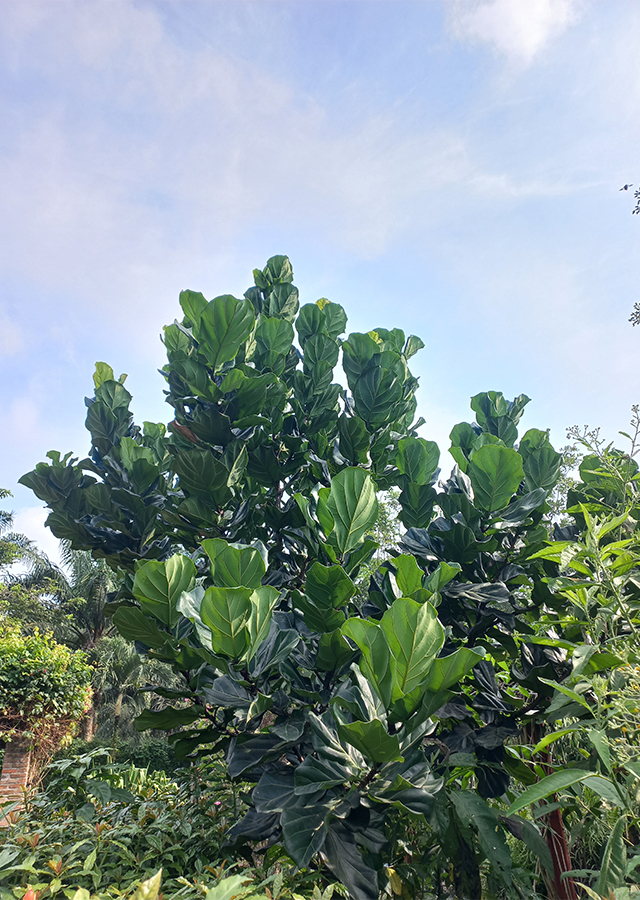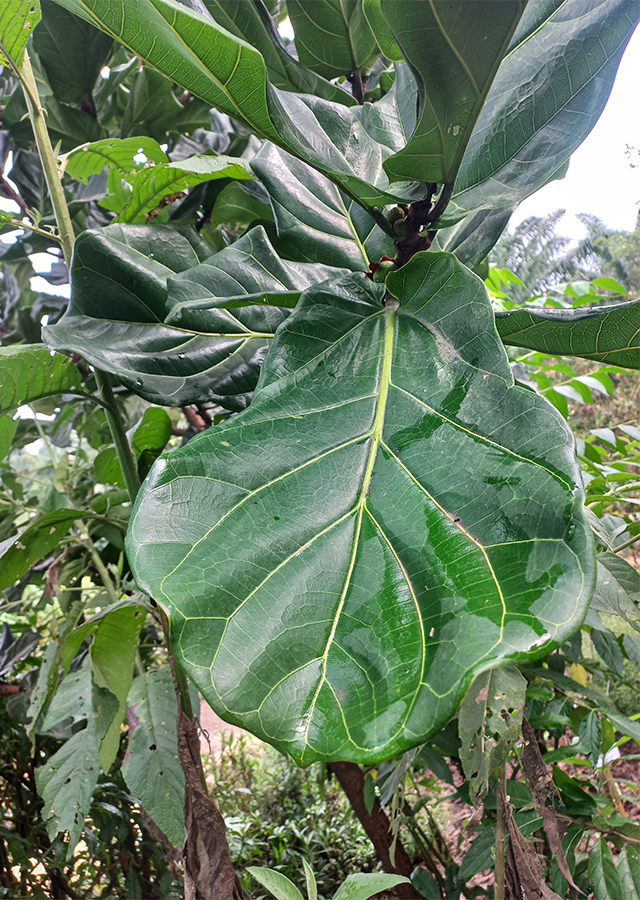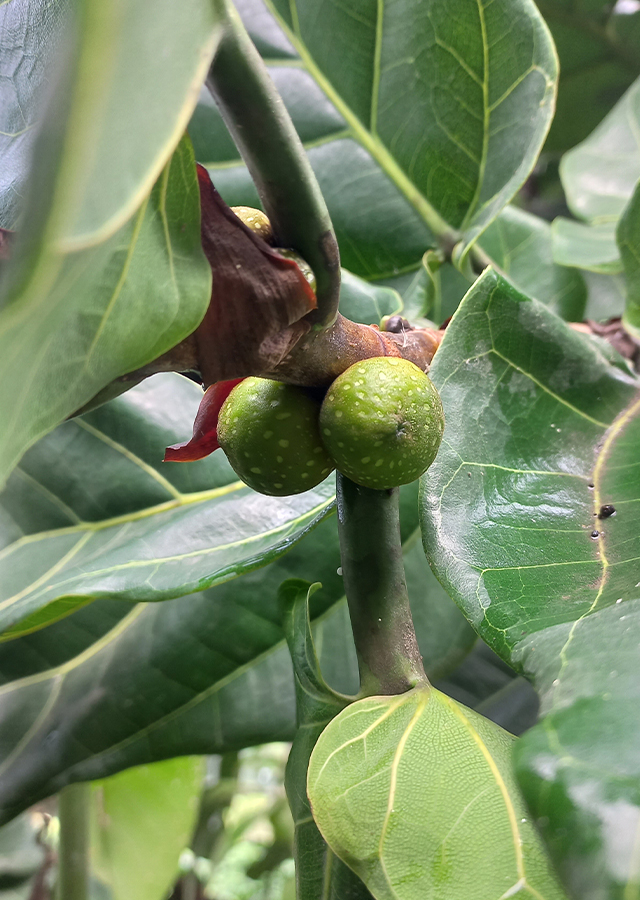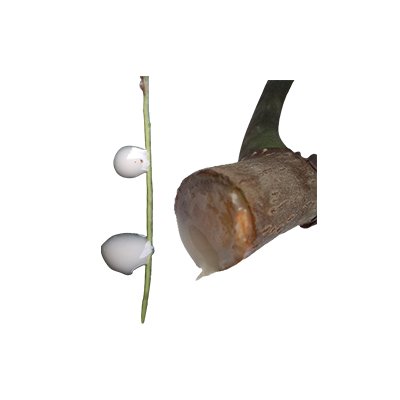Fiddle Leaf Fig
Ficus lyrata Warb.
Moraceae
Location in our garden
Principal



Synonym
Ficus pandurata Sander
Habitus
Trees. Is a tree, growing up to 12 m in height when planted in the ground, but up to 30 m in its natural habitat.
Part Used
Leaves
Fruit
Latex
The Whole Plant
Growing Requirements
Full Sunshine
Need Shade
Drought Resistant
Habitat
Forest
Coastal
Roadside
Terrestrial
Overview
Ficus lyrata is a plant from the Moraceae family originating from tropical West and Central Africa, has been introduced to Asia (Indonesia, Pakistan, Singapore), Europe, North and South America, and is cultivated throughout the world including the West Indies. This species has long been cultivated by the community as an ornamental plant (both indoors and outdoors) in tropical and temperate climates, shade plants, medicinal plants, natural dyes for clothing (producing a purplish red color), is also known to have social meanings, as described above.
Vernacular Names
Geigenfeige (German), Kashiwa bagomu (Japanese), Banjo fig (Philippines).
Agroecology
Grows in low to moderate plains and in the moist rain forest of pramontana. In Colombia, this species is reported to grow at an altitude of 1,000-1,500 m asl. In Indonesia, this species grows almost in all parts of the region, usually growing wild on the beach or on the side of the road. Fiddle leaf fig has a high tolerance for drought and can grow in full sun, partial sun, or partial shade. This species also has a moderate tolerance to aerosolized salts and can grow in a wide variety of soils including sand, clay, loam, alkaline and acidic as long as the soil is well drained. The plant does not like excessive watering. Too much or too little water and insufficient light will result in the death of old lower leaves.
Morphology
- Roots - fibrous and tap root.
- Stems - solitary, woody, with grayish shallowly cracked bark.
- Leaves - 2-5 cm long, glabrous, grooved petiole; lamina thick fiddle-shaped or pandurate, 15-30 cm long, 12-20 cm 9-10-costate at the cordate base, sinuate-entire, almost truncate and very shortly acuminate at the apex, glabrous, lateral nerves 4-5 pairs, bulging beneath intercostals present; stipules narrowly triangular-lanceolate, 4-5 cm long, acuminate, glabrous, persistent.
- Flowers - male flowers: sepals 2-3, ovate-lanceolate; stamen solitary with ovoid anther. Female flowers; sepals 3, ovate, obtuse; style short with papillate stigma.
- Fruits - round, hollow synconium fleshy, green with depressed yellow spots, very dense and hard, stemless, paired in leaf axils at branch tips.
Cultivation
Propagated by seeds, stem cuttings (using rooting hormones), and layering (using 1 - 2 year old branches).
Chemical Constituents
Alkaloids, phenolic compounds, tannins, terpenoids, orientin, benzoic acid, caffeoylquinic acid, fatty acids and sphingolipids, flavonoids (including catechins/procyanidins, O- and C-linked flavonoid glycosides), arabinose, β-amyrins, β-carotenes, xanthotoxol, β-sitosterol. The main procyanidins are dimers and trimers consisting of (epi)catechin and (epi)afzelechin units, while the dominant flavones are C-glycosides or luteolin and apigenin.
Traditional Medicinal Uses
- Treats respiratory disorders (asthma, cough, sore throat), gastrointestinal disorders (colic, indigestion, loss of appetite, and diarrhea), inflammatory and cardiovascular disorders.
- Treats conditions such as fungal infections.
- Figs are used to control diabetes.
- Has antimicrobial and antioxidant activity.
Part Used
Reference Sources
- Royal Botanic Gardens, Kew. Plants of the World Online: Ficus lyrata Warb.. https://powo.science.kew.org/taxon/urn:lsid:ipni.org:names:853158-1. 24-07-22.
- CAB International. 2014. Invasive Species Compendium: Ficus lyrata (fiddle-leaf fig). https://www.cabi.org/isc/datasheet/24125#touses. 24-07-22.
- Flora Fauna Web. 2022. Ficus lyrata Warb.. https://www.nparks.gov.sg/florafaunaweb/flora/2/9/2911. 24-07-22.
- Stuartxchange. 2021. Philippine Medicinal Plants: Fiddle leaf fig. http://www.stuartxchange.org/FiddleLeaf. 24-07-22.
- Alamgeer et al. 2018. Traditional medicinal plants used for respiratory disorders in Pakistan: a review of the ethno-medicinal and pharmacological evidence. Chinese Medicine, 13: 48. doi: 10.1186/s13020-018-0204-y.
- Lostinplantopia. 2018. Ficus lyrata. https://lostinplantopia.com/2018/11/30/011-ficus-lyrata/. 24-07-22.
- Khan A. S. 2017. Medicinally Important Trees. Springer International Publishing AG.



